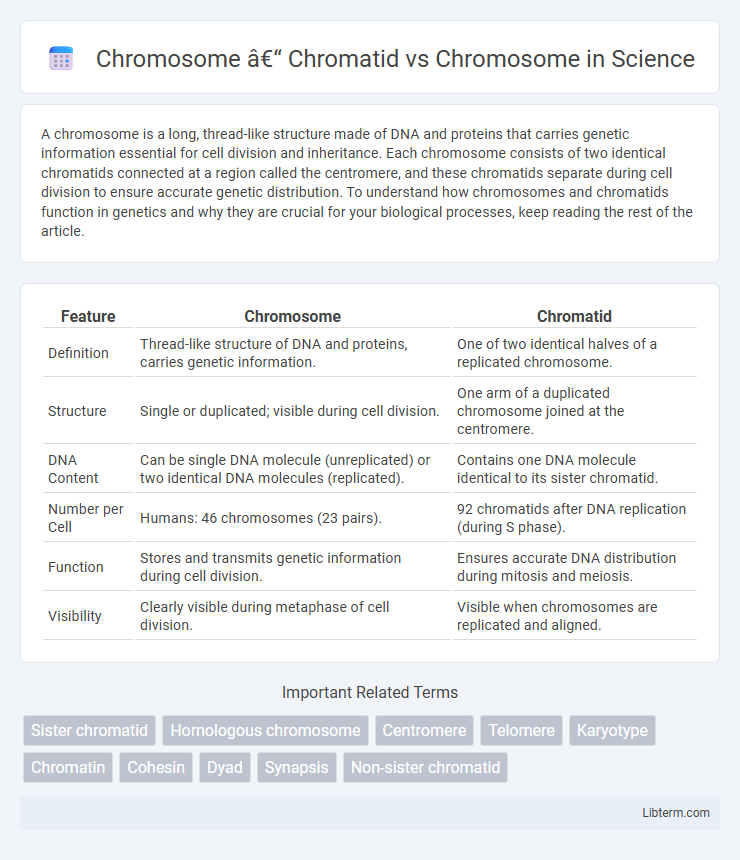A chromosome is a long, thread-like structure made of DNA and proteins that carries genetic information essential for cell division and inheritance. Each chromosome consists of two identical chromatids connected at a region called the centromere, and these chromatids separate during cell division to ensure accurate genetic distribution. To understand how chromosomes and chromatids function in genetics and why they are crucial for your biological processes, keep reading the rest of the article.
Table of Comparison
| Feature | Chromosome | Chromatid |
|---|---|---|
| Definition | Thread-like structure of DNA and proteins, carries genetic information. | One of two identical halves of a replicated chromosome. |
| Structure | Single or duplicated; visible during cell division. | One arm of a duplicated chromosome joined at the centromere. |
| DNA Content | Can be single DNA molecule (unreplicated) or two identical DNA molecules (replicated). | Contains one DNA molecule identical to its sister chromatid. |
| Number per Cell | Humans: 46 chromosomes (23 pairs). | 92 chromatids after DNA replication (during S phase). |
| Function | Stores and transmits genetic information during cell division. | Ensures accurate DNA distribution during mitosis and meiosis. |
| Visibility | Clearly visible during metaphase of cell division. | Visible when chromosomes are replicated and aligned. |
Introduction to Chromosomes and Chromatids
Chromosomes are thread-like structures composed of DNA and proteins that carry genetic information essential for cell division and heredity. Each chromosome consists of two identical chromatids, called sister chromatids, joined at a region known as the centromere, particularly visible during cell division phases like mitosis and meiosis. Chromatids become individual chromosomes when separated, ensuring accurate distribution of genetic material to daughter cells during replication and cell division processes.
Overview of Chromosomal Structure
Chromosomes consist of two identical sister chromatids joined at a centromere, forming the fundamental units of genetic material during cell division. Each chromatid contains a single, continuous DNA molecule wrapped around histone proteins, creating a highly organized chromatin structure. The chromosomal architecture ensures accurate DNA replication and segregation, with chromatids separating during anaphase to form individual chromosomes in daughter cells.
Defining Chromosomes: Function and Composition
Chromosomes are thread-like structures composed of DNA and proteins that carry genetic information essential for cell division and hereditary function. Each chromosome consists of two chromatids joined at a centromere, with chromatids representing identical DNA copies formed during DNA replication. The structural integrity and proper segregation of chromosomes ensure accurate gene transmission to daughter cells, maintaining genetic stability.
What Are Chromatids?
Chromatids are identical halves of a duplicated chromosome, formed during the S phase of the cell cycle, and connected by a centromere. Each chromatid carries an exact copy of the DNA sequence, ensuring genetic consistency during cell division. During mitosis and meiosis, chromatids separate to become individual chromosomes, facilitating accurate genetic distribution to daughter cells.
Key Differences: Chromatid vs Chromosome
A chromosome consists of a single molecule of DNA that carries genetic information, while a chromatid refers to one of the two identical halves of a duplicated chromosome formed during DNA replication. Chromatids remain joined at a region called the centromere until they separate during cell division, resulting in two independent chromosomes. The key difference lies in their structural and functional state: chromatids exist only during the cell cycle phases S, G2, and mitosis as part of a replicated chromosome, whereas chromosomes describe the DNA structure in both replicated and unreplicated forms.
Chromosome Duplication and Chromatid Formation
Chromosome duplication occurs during the S phase of the cell cycle, resulting in each chromosome consisting of two identical sister chromatids connected at a region called the centromere. These sister chromatids ensure accurate segregation of genetic material during mitosis and meiosis, with each chromatid serving as a complete DNA molecule. The transition from a single chromosome to duplicated sister chromatids is essential for maintaining genomic integrity during cell division.
Role of Chromatids in Cell Division
Chromatids play a crucial role in cell division by ensuring accurate genetic material distribution during mitosis and meiosis. Each chromosome consists of two sister chromatids connected at the centromere, which separate to form individual chromosomes in daughter cells, preserving genetic integrity. The separation of chromatids during anaphase guarantees that each new cell receives an identical set of chromosomes essential for proper cellular function and development.
Chromosomes and Genetics: Inheritance Patterns
Chromosomes carry the genetic information essential for inheritance, with each chromosome composed of two sister chromatids joined at the centromere during cell division. The arrangement and number of chromosomes determine an organism's genetic traits, influencing Mendelian and non-Mendelian patterns of inheritance. Chromosomal abnormalities, such as duplications, deletions, or translocations, can significantly affect inheritance patterns and genetic disorders.
Common Misconceptions: Chromosomes vs Chromatids
Chromosomes are structures composed of DNA and proteins that carry genetic information, whereas chromatids refer to each of the two identical halves of a duplicated chromosome joined at the centromere. A common misconception is confusing chromosomes with chromatids, particularly during cell division phases like mitosis and meiosis where chromatids become visible as distinct entities. Understanding that a chromosome consists of one chromatid before DNA replication and two sister chromatids after replication helps clarify their distinct roles in genetic inheritance.
Importance of Chromosomal Understanding in Biology
Chromosomes, consisting of two identical chromatids joined at a centromere, carry genetic information crucial for cell division and heredity. Understanding chromosome structure and behavior is vital for comprehending genetic inheritance, mutation effects, and chromosomal disorders such as Down syndrome and Turner syndrome. Advances in chromosomal research enable breakthroughs in genetics, medicine, and biotechnology by revealing mechanisms behind gene expression and cellular replication.
Chromosome – Chromatid Infographic

 libterm.com
libterm.com